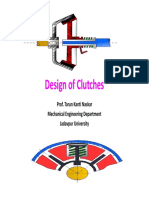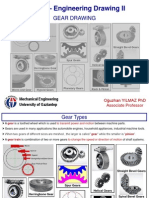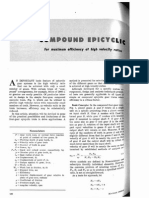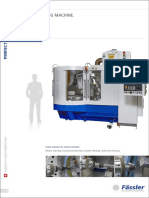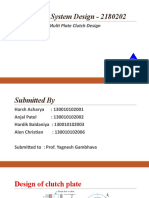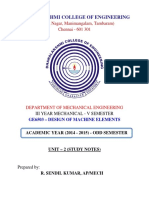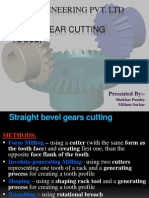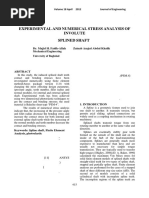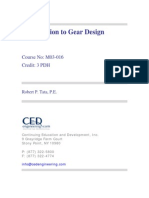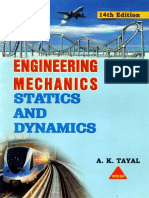Mass Moment of Inertia Formulas PDF
Mass Moment of Inertia Formulas PDF
Uploaded by
Asrar AhmedCopyright:
Available Formats
Mass Moment of Inertia Formulas PDF
Mass Moment of Inertia Formulas PDF
Uploaded by
Asrar AhmedOriginal Title
Copyright
Available Formats
Share this document
Did you find this document useful?
Is this content inappropriate?
Copyright:
Available Formats
Mass Moment of Inertia Formulas PDF
Mass Moment of Inertia Formulas PDF
Uploaded by
Asrar AhmedCopyright:
Available Formats
Inertia Calculations
Cylindrical object (solid) of diameter D (radius R=D/2) and mass, M
1 1 MR 2 = MD 2 2 8 1 1 = lR 4 = lD 4 2 32 Jaa =mass moment of inertia about axis aa (polar moment of inertia) =density of the material l=length of cylinder J aa =
Cylindrical object (hollow) with inner diameter Di (radius Ri=Di/2), outer diameter Do (radius Ro=Do/2), and mass, M
a
J aa =
a
1 1 2 2 M (R o + R i2 ) = M (D o + D i2 ) 2 8 1 1 4 4 = l(R o R i4 ) = l(D o D i4 ) 2 32
Direct drive load
Load
Jtot = Jmotor armature + Jload
*Note: Shafts do have inertia, but their contribution to Jtot is often negligible. Why?
Gear driven load
N1
gear 1 N3 gear 3 Load N4 gear 4
N2 gear 2
Jtot = Jmotor armature + Jgear 1 + (N1/N2)2 [Jgear 2 + Jgear 3 + (N3/N4)2 {Jgear 4 + Jload}] Ni is the number of gear teeth on gear i. Ni/Nj is the gear ratio between gears i and j. (Note that the polar moment of inertia terms in the equation above refer to their central principal values about their axes of rotation) Leadscrew driven load
J tot = J motor armature + J leadscrew + M 1 (2p ) 2 e
p = leadscrew pitch (threads/length) e = efficiency of leadscrew M = mass of load = density of leadscrew material
Tangentially driven load Jtot = Jmotor + Jpulley1 + Jpulley2 + MR2 + MbeltR2 M where Jpulley i is the polar moment of inertia for pulley i about its rotational axis, Mbelt is the mass of the belt, and R is the radius of both pulleys.
You might also like
- System Dynamics and Respinse Kelly Solutions100% (6)System Dynamics and Respinse Kelly Solutions447 pages
- Design II MDE 221 Mott CH 8 and CH 9 Spur GearsNo ratings yetDesign II MDE 221 Mott CH 8 and CH 9 Spur Gears42 pages
- Motor Torque Calculation: Lead Screw Drive Loads100% (1)Motor Torque Calculation: Lead Screw Drive Loads5 pages
- Design Procedure of Gear Box For Automobile and Machine Tools0% (1)Design Procedure of Gear Box For Automobile and Machine Tools10 pages
- Moog-Ball Screws Planetary Roller Screws-DatasheetNo ratings yetMoog-Ball Screws Planetary Roller Screws-Datasheet2 pages
- Adaptive Design of Machine Tool GearboxesNo ratings yetAdaptive Design of Machine Tool Gearboxes9 pages
- Spur - Gears - Metric - XLS: Tooth Normal ForceNo ratings yetSpur - Gears - Metric - XLS: Tooth Normal Force5 pages
- Unit-Iii Bevel Gears: Prepared by R. Sendil KumarNo ratings yetUnit-Iii Bevel Gears: Prepared by R. Sendil Kumar23 pages
- The Effect of Center Distance Change On Gear Teeth EngagementNo ratings yetThe Effect of Center Distance Change On Gear Teeth Engagement21 pages
- Mak4462 Machine Tools: Yildiz Technical University Faculty of Mechanical Engineering Department of Mechanical EngineeringNo ratings yetMak4462 Machine Tools: Yildiz Technical University Faculty of Mechanical Engineering Department of Mechanical Engineering12 pages
- Design of Transmission Systems-Question Bank100% (1)Design of Transmission Systems-Question Bank28 pages
- Determine Material Property (PSG Data Book Page No 1.9 & 1.5)100% (1)Determine Material Property (PSG Data Book Page No 1.9 & 1.5)28 pages
- 10.3 Calculation For Cylindrical Worm Gear Pair StrengthNo ratings yet10.3 Calculation For Cylindrical Worm Gear Pair Strength7 pages
- Chapter (5) Di Fsidl Dsidls T Design of Spindles and Spindle SupportsNo ratings yetChapter (5) Di Fsidl Dsidls T Design of Spindles and Spindle Supports16 pages
- Inertia Calculations: MD 8 1 MR 2 1 J πρ = πρ = = =No ratings yetInertia Calculations: MD 8 1 MR 2 1 J πρ = πρ = = =2 pages
- Aqm - Rotations in Quantum Mechanics PDFNo ratings yetAqm - Rotations in Quantum Mechanics PDF4 pages
- Cylindrical Compression Helix Springs For Suspension SystemsFrom EverandCylindrical Compression Helix Springs For Suspension SystemsNo ratings yet
- Innovative Valve Train Systems: Technology Highlights and R&D Activities at FEVNo ratings yetInnovative Valve Train Systems: Technology Highlights and R&D Activities at FEV8 pages
- Engineering Mathematics Course Outline For 2020 2021 Academic Year-1-1No ratings yetEngineering Mathematics Course Outline For 2020 2021 Academic Year-1-12 pages
- AP Physics 1 First Semester Review SheetNo ratings yetAP Physics 1 First Semester Review Sheet14 pages
- The MIT Humanoid Robot Design Motion Planning and Control For Acrobatic Behaviors (Rmipr)No ratings yetThe MIT Humanoid Robot Design Motion Planning and Control For Acrobatic Behaviors (Rmipr)8 pages
- 13.07.22 Bitsat Full Test-2 Paper Solutions PDFNo ratings yet13.07.22 Bitsat Full Test-2 Paper Solutions PDF37 pages
- Class 11 Physics Unit 5 Motion of System of Particle and Rigid BodyNo ratings yetClass 11 Physics Unit 5 Motion of System of Particle and Rigid Body38 pages
- Moment of Inertia and Radius of GyrationNo ratings yetMoment of Inertia and Radius of Gyration2 pages
- Solutions AIATS Med-2020 Test-2 (Code-E & F) 17-11-20190% (1)Solutions AIATS Med-2020 Test-2 (Code-E & F) 17-11-201932 pages
- Massachusetts Institute of Technology Department of Physics Physics 8.01 IC - W09D1-2 Moment of Inertia Uniform Rod SolutionNo ratings yetMassachusetts Institute of Technology Department of Physics Physics 8.01 IC - W09D1-2 Moment of Inertia Uniform Rod Solution3 pages
- The Amazing Variety of Motions of A Loaded Hoop: W.F.D. Theron, M.F. MaritzNo ratings yetThe Amazing Variety of Motions of A Loaded Hoop: W.F.D. Theron, M.F. Maritz12 pages
- 5 Module Centroid and Moment of IntertiaNo ratings yet5 Module Centroid and Moment of Intertia49 pages
- CLASS XI PHYSICS System of Particles QuestionsNo ratings yetCLASS XI PHYSICS System of Particles Questions2 pages








